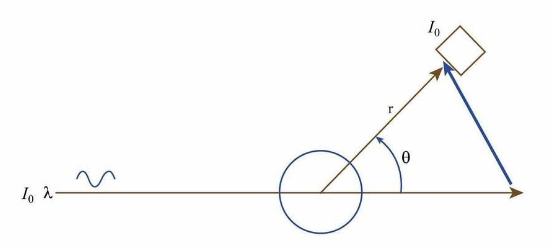
What is the Scattering angle?
Answer
387k+ views
Hint: Scattering is a term used in physics to describe a wide range of physical processes in which localised non-uniformities (including particles and radiation) in the medium through which they pass cause moving particles or radiation of some form, such as light or sound, to deviate from a straight trajectory. This also includes divergence of reflected radiation from the angle anticipated by the law of reflection in traditional usage.
Complete answer:
Small-angle scattering (SAS) is a scattering technique that involves deflecting collimated radiation away from the straight path when it contacts objects considerably bigger than the wavelength of the radiation. Because the deflection is tiny ( $ 0.1 - 10^\circ $ ), the moniker "small-angle" was coined. The size, shape, and orientation of structures in a sample may be determined using SAS methods. SAS is a strong approach for studying large-scale structures with dimensions ranging from tens of thousands to tens of thousands of angstroms.
The SAS method's most essential characteristic is its ability to analyse the underlying structure of disordered systems, and it's often the only option to get direct structural information on systems with a random arrangement of density inhomogeneities at such vast sizes. The SAS approach is now a self-contained area of structural analysis of matter, with well-developed experimental and theoretical techniques and a large range of examined objects. Small angle neutron scattering (SANS) or small angle X-ray scattering (SAS) are two terms that can be used interchangeably (SAXS).
The angle at which a light beam is deflected by a particle when it comes into contact with it is known as the scattering angle.

Here $ \theta $ is the scattered angle.
Note:
Single scattering occurs when radiation is dispersed by only one localised scattering site. Scattering centres are frequently clustered together; in such circumstances, radiation may scatter several times, resulting in multiple scattering. The main difference between single and multiple scattering effects is that single scattering can usually be treated as a random phenomenon, whereas multiple scattering can be modelled as a more deterministic process, despite the fact that the combined results of a large number of scattering events tend to average out. Diffusion theory may often be used to simulate multiple scattering.
Complete answer:
Small-angle scattering (SAS) is a scattering technique that involves deflecting collimated radiation away from the straight path when it contacts objects considerably bigger than the wavelength of the radiation. Because the deflection is tiny ( $ 0.1 - 10^\circ $ ), the moniker "small-angle" was coined. The size, shape, and orientation of structures in a sample may be determined using SAS methods. SAS is a strong approach for studying large-scale structures with dimensions ranging from tens of thousands to tens of thousands of angstroms.
The SAS method's most essential characteristic is its ability to analyse the underlying structure of disordered systems, and it's often the only option to get direct structural information on systems with a random arrangement of density inhomogeneities at such vast sizes. The SAS approach is now a self-contained area of structural analysis of matter, with well-developed experimental and theoretical techniques and a large range of examined objects. Small angle neutron scattering (SANS) or small angle X-ray scattering (SAS) are two terms that can be used interchangeably (SAXS).
The angle at which a light beam is deflected by a particle when it comes into contact with it is known as the scattering angle.

Here $ \theta $ is the scattered angle.
Note:
Single scattering occurs when radiation is dispersed by only one localised scattering site. Scattering centres are frequently clustered together; in such circumstances, radiation may scatter several times, resulting in multiple scattering. The main difference between single and multiple scattering effects is that single scattering can usually be treated as a random phenomenon, whereas multiple scattering can be modelled as a more deterministic process, despite the fact that the combined results of a large number of scattering events tend to average out. Diffusion theory may often be used to simulate multiple scattering.
Recently Updated Pages
Glucose when reduced with HI and red Phosphorus gives class 11 chemistry CBSE

The highest possible oxidation states of Uranium and class 11 chemistry CBSE

Find the value of x if the mode of the following data class 11 maths CBSE

Which of the following can be used in the Friedel Crafts class 11 chemistry CBSE

A sphere of mass 40 kg is attracted by a second sphere class 11 physics CBSE

Statement I Reactivity of aluminium decreases when class 11 chemistry CBSE

Trending doubts
10 examples of friction in our daily life

The correct order of melting point of 14th group elements class 11 chemistry CBSE

Difference Between Prokaryotic Cells and Eukaryotic Cells

One Metric ton is equal to kg A 10000 B 1000 C 100 class 11 physics CBSE

State and prove Bernoullis theorem class 11 physics CBSE

What organs are located on the left side of your body class 11 biology CBSE




